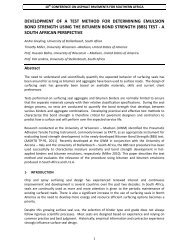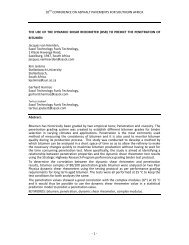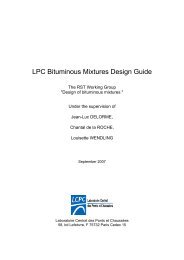Guide to the safe handling of solvents in a bituminous ... - Aapaq.org
Guide to the safe handling of solvents in a bituminous ... - Aapaq.org
Guide to the safe handling of solvents in a bituminous ... - Aapaq.org
- No tags were found...
You also want an ePaper? Increase the reach of your titles
YUMPU automatically turns print PDFs into web optimized ePapers that Google loves.
Locate and know how <strong>to</strong> test and operate emergency equipment,such as showers and eyewashes, <strong>in</strong> your area; Learn first aid: Contact an appropriate <strong>org</strong>anisation for first aidtra<strong>in</strong><strong>in</strong>g. The emergency first aid procedures described belowshould be followed by a consultation with a physician for medicaltreatment.• Burns: In <strong>the</strong> labora<strong>to</strong>ry, <strong>the</strong>rmal burns may be caused by <strong>in</strong>tenseheat, flames, molten metal, steam, etc. Corrosive liquids or solidssuch as bases and acids can cause chemical burns; first aidtreatment for chemical burns is described <strong>in</strong> sub-section: Chemicalsplashes <strong>to</strong> <strong>the</strong> sk<strong>in</strong> or eyes, below. In electrical burns, electricalcurrent pass<strong>in</strong>g through <strong>the</strong> body generates heat. Burns <strong>to</strong> <strong>the</strong> sk<strong>in</strong>: First aid treatment <strong>of</strong> sk<strong>in</strong> burns encompasses<strong>the</strong> follow<strong>in</strong>g:¨If <strong>the</strong> burn is electrical <strong>in</strong> orig<strong>in</strong>, ascerta<strong>in</strong> that <strong>the</strong> victim is not<strong>in</strong> contact with <strong>the</strong> power supply before <strong>to</strong>uch<strong>in</strong>g him/her. If <strong>the</strong>victim rema<strong>in</strong>s <strong>in</strong> contact with a power source, unplug <strong>the</strong>device or shut <strong>of</strong>f <strong>the</strong> ma<strong>in</strong> power switch at <strong>the</strong> electricaldistribution panel;¨ Dial <strong>the</strong> emergency number if <strong>the</strong> burn is serious. Seekimmediate medical treatment for all electrical burns, even if<strong>the</strong>y don’t appear <strong>to</strong> be serious;¨ Remove jewellery, <strong>in</strong>clud<strong>in</strong>g watches, from <strong>the</strong> burned area;¨ Expose <strong>the</strong> burnt area, but avoid remov<strong>in</strong>g clo<strong>the</strong>s that arestuck <strong>to</strong> <strong>the</strong> sk<strong>in</strong>;¨ If possible, immerse burnt surfaces <strong>in</strong> cold water for at least 10m<strong>in</strong>utes, or apply cold wet packs;¨ Avoid apply<strong>in</strong>g lotions, o<strong>in</strong>tments or dis<strong>in</strong>fectants <strong>to</strong> a burn.First and second degree burns can be washed with soap andwater after <strong>the</strong> cool down period;¨ Cover first and second degree burns with a moist bandage;apply dry compresses <strong>to</strong> third degree burns and <strong>to</strong> entry andexit wounds <strong>of</strong> electrical burns;¨ Do not burst blisters, as <strong>the</strong>y form a natural barrier aga<strong>in</strong>st<strong>in</strong>fection. Burns <strong>to</strong> <strong>the</strong> eyes: Burns <strong>to</strong> <strong>the</strong> eyes may be caused by chemicalsubstances, heat (hot liquids, steam, open flames, molten metal,etc.), or radiation from weld<strong>in</strong>g procedures, labora<strong>to</strong>ry lamps andlasers. Burns caused by ultraviolet, visible or near-<strong>in</strong>fraredradiation may not produce symp<strong>to</strong>ms until 6-8 hours after71
















